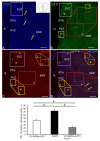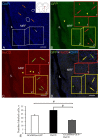A Confocal Microscopic Study of Gene Transfer into the Mesencephalic Tegmentum of Juvenile Chum Salmon, Oncorhynchus keta, Using Mouse Adeno-Associated Viral Vectors
- PMID: 34073457
- PMCID: PMC8199053
- DOI: 10.3390/ijms22115661
A Confocal Microscopic Study of Gene Transfer into the Mesencephalic Tegmentum of Juvenile Chum Salmon, Oncorhynchus keta, Using Mouse Adeno-Associated Viral Vectors
Abstract
To date, data on the presence of adenoviral receptors in fish are very limited. In the present work, we used mouse recombinant adeno-associated viral vectors (rAAV) with a calcium indicator of the latest generation GCaMP6m that are usually applied for the dorsal hippocampus of mice but were not previously used for gene delivery into fish brain. The aim of our work was to study the feasibility of transduction of rAAV in the mouse hippocampus into brain cells of juvenile chum salmon and subsequent determination of the phenotype of rAAV-labeled cells by confocal laser scanning microscopy (CLSM). Delivery of the gene in vivo was carried out by intracranial injection of a GCaMP6m-GFP-containing vector directly into the mesencephalic tegmentum region of juvenile (one-year-old) chum salmon, Oncorhynchus keta. AAV incorporation into brain cells of the juvenile chum salmon was assessed at 1 week after a single injection of the vector. AAV expression in various areas of the thalamus, pretectum, posterior-tuberal region, postcommissural region, medial and lateral regions of the tegmentum, and mesencephalic reticular formation of juvenile O. keta was evaluated using CLSM followed by immunohistochemical analysis of the localization of the neuron-specific calcium binding protein HuCD in combination with nuclear staining with DAPI. The results of the analysis showed partial colocalization of cells expressing GCaMP6m-GFP with red fluorescent HuCD protein. Thus, cells of the thalamus, posterior tuberal region, mesencephalic tegmentum, cells of the accessory visual system, mesencephalic reticular formation, hypothalamus, and postcommissural region of the mesencephalon of juvenile chum salmon expressing GCaMP6m-GFP were attributed to the neuron-specific line of chum salmon brain cells, which indicates the ability of hippocampal mammal rAAV to integrate into neurons of the central nervous system of fish with subsequent expression of viral proteins, which obviously indicates the neuronal expression of a mammalian adenoviral receptor homolog by juvenile chum salmon neurons.
Keywords: Oncorhynchus keta; adeno-associated virus; calcium binding protein HuCD; dorsal thalamus; hypothalamus; mesencephalic reticular formation; postcommissural region; posterior tuberal region; pretectal nuclei; tegmentum.
Conflict of interest statement
The authors declare no conflict of interest.
Figures









Similar articles
-
Transduction of Brain Neurons in Juvenile Chum Salmon (Oncorhynchus keta) with Recombinant Adeno-Associated Hippocampal Virus Injected into the Cerebellum during Long-Term Monitoring.Int J Mol Sci. 2022 Apr 29;23(9):4947. doi: 10.3390/ijms23094947. Int J Mol Sci. 2022. PMID: 35563338 Free PMC article.
-
Ultrastructural Study and Immunohistochemical Characteristics of Mesencephalic Tegmentum in Juvenile Chum Salmon (Oncorhynchus keta) Brain After Acute Traumatic Injury.Int J Mol Sci. 2025 Jan 14;26(2):644. doi: 10.3390/ijms26020644. Int J Mol Sci. 2025. PMID: 39859360 Free PMC article.
-
Neural Stem Cells/Neuronal Precursor Cells and Postmitotic Neuroblasts in Constitutive Neurogenesis and After ,Traumatic Injury to the Mesencephalic Tegmentum of Juvenile Chum Salmon, Oncorhynchus keta.Brain Sci. 2020 Jan 25;10(2):65. doi: 10.3390/brainsci10020065. Brain Sci. 2020. PMID: 31991815 Free PMC article.
-
Expression of Fushi tarazu factor 1 homolog and Pit-1 genes in the pituitaries of pre-spawning chum and sockeye salmon.Comp Biochem Physiol B Biochem Mol Biol. 2001 Jun;129(2-3):503-9. doi: 10.1016/s1096-4959(01)00348-7. Comp Biochem Physiol B Biochem Mol Biol. 2001. PMID: 11399485 Review.
-
Pharmacological Activity and Clinical Use of PDRN.Front Pharmacol. 2017 Apr 26;8:224. doi: 10.3389/fphar.2017.00224. eCollection 2017. Front Pharmacol. 2017. PMID: 28491036 Free PMC article. Review.
Cited by
-
Adult Neurogenesis of Teleost Fish Determines High Neuronal Plasticity and Regeneration.Int J Mol Sci. 2024 Mar 25;25(7):3658. doi: 10.3390/ijms25073658. Int J Mol Sci. 2024. PMID: 38612470 Free PMC article. Review.
-
Transduction of Brain Neurons in Juvenile Chum Salmon (Oncorhynchus keta) with Recombinant Adeno-Associated Hippocampal Virus Injected into the Cerebellum during Long-Term Monitoring.Int J Mol Sci. 2022 Apr 29;23(9):4947. doi: 10.3390/ijms23094947. Int J Mol Sci. 2022. PMID: 35563338 Free PMC article.
References
MeSH terms
Grants and funding
LinkOut - more resources
Full Text Sources

